
The hilltop city of Perugia, in central Italy, is a microcosm of the adversities that exist within the Italian judicial system as a whole. It has shown, by example, the tentacles that are wound through the system which are strangling the Inviolable Rights of Italians and foreigners alike. As American I, too, am fully aware of the intricacies of living under an imperfect system, in fact, for over 10,000 years man has tried and failed to create a perfect set of mandates to protect the rights of citizen and state.
The trials of Raffaele Sollecito and Amanda Knox for the 2007 murder of Meredith Kercher have been conducted from 2007 to present in Perugia, Rome and Florence. These hearings have astounded outsiders who expected the letter of the law to be followed. Instead we were treated what we called a “soap opera that defied all reason” and see what is happening to the students as a monumental failure of the correct application Italian law.
Since 2007 I’ve heard the word “mistake” used to describe many aspects of this case. By the defense and prosecution teams in court and by the defendant families outside of court, I soon discovered that the term is a very delicate and diplomatic way of saying that Perugian authorities lied, cheated and were duplicitous in presenting their case. Italy requires “delicate” words because no one is allowed to use inflammatory language when referring to law enforcement or the judiciary.
For years now I have thrashed the Perugian officials soundly in my writing and have openly accused Giuliano Mignini many, many times of duplicity and corruption. I am understandably angry by what they have done to people that my community cares deeply about. I have found that many Italians feel constrained by their system, not even comfortable enough to speak freely in the blogosphere. So my open contempt of Mignini and his technical consultants is shocking to them and even a tad bit scary as some of what I write is illegal in Italy under the Honor Laws.
As I delved into Italian civics, I found that my old pal Giuliano is part of a huge bureaucracy, not unlike the American one I live under, and in many respects he is just a cog in the wheel. And I found that the Italian judiciary regularly deals with “unusual” prosecutorial theories, so where Mignini is a villain in my world, he is a nobody (or was a nobody) in Italy, a simple magistrate in a po-dink college town, just like the magistrates here at home. That may be, but he is still a dirty old man in my book for what he said my friend’s innocent daughter did.
The Secretary will disavow any knowledge of my actions. This essay will self-destruct five seconds after you finish reading it.
INVIOLABLE RIGHTS TRAMPLED
In a court of law, when the truth is being sought, Italy affirms that each citizen and foreigner has “Inviolable Rights” under the Constitution. But it appears that the upper courts are hamstrung by a decree that, in effect, crushes the Inviolable Rights of all parties in a litigation.
Italy’s judges have declared on numerous occasions that they are able to “only rule on what is before the court,” in other words, whatever is written in the documentation sitting on their respective benches. The lower levels do the investigation and the higher levels check to make sure the paperwork is correct. Bureaucratic redundancy is supposed to protect citizens and the Supreme Court is charged with that sacred duty, above all other courts.
Therefore IF what is “before the court” is misinformation, then HOW can the court rule fairly? How can the court protect inviolable rights? What should the Supreme Court do about such a case, knowing that what is “before” them is based on false information?
It appears that a simple phrase is trampling rights that are sacred under the law. In the case of Knox and Sollecito vs. The State, from the very first papers signed in the interrogation rooms on November 6, 2007 the file has been built upon lies and misinformation manipulated by the Perugian Public Prosecutor’s office and the police. What is before the court, at all levels, is factually incorrect.
Ruling on factually incorrect information, therefore, violates the sacred rights of Raffaele, Amanda and Meredith.
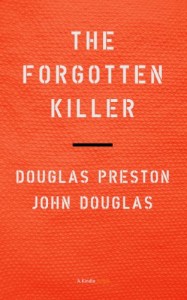
THE FORGOTTEN KILLER
Rudy Guede is getting away with murder because a “fast-track trial” runs even a killer quickly through the Italian system. He received, as punishment for stabbing Meredith Kercher to death, a legal slap on the wrist and he will be eligible for parole after only six years in prison. To the layperson, such as I, it looks like payment for his cooperation and protection by the Perugians. It also seems very odd that the lawyers for the murderer and the victim would team up in court, and against such obviously innocent people, while the real murderer is pandered to. Why did he, the thief-turned-killer, get such a light sentence while innocent university students are mercilessly forced into prison?
THERE ARE MISTAKES AND “MISTAKES”
True mistakes were made, as evidenced by the police videos taped at Via Della Pergola 7, but not everything can be explained by this shocking footage. In ever increasing numbers, professionals are saying that Raffaele and Amanda have been framed and point to contradictions in court documents that demonstrate outright breaking of Italy’s laws.
Both are currently being persecuted by a vendetta in the classic sense, cloaked as a monumental effort to save the face of the Perugian judiciary, the Scientific Police and now the Court of Cassation (Italy’s Supreme Court). No one seems to want to admit that obvious, glaring mistakes have been made and so they are willing to sacrifice the freedom, and lives, of two innocent young adults. Only two judges in Italy have had the balls to say that the Emperor has no clothes.
Sitting in front of dozens of judges (from 2007 to present) are files that are either completely untrue or prejudicially edited.
Nearly every Honor Law has been broken against Raffaele and Amanda by the Italian system using information that the average high school debate team could destroy. Unless the Supreme Court takes action to stop the proceedings and get to the truth of the matter, the only outcome can be who is the most influential, the defense or the prosecution.
In the case of Knox and Sollecito vs. the State it is the Prosecution. The Deputy Public Prosecutor of Perugia controlled the investigation, the labs, the court system and leaks to the media. And then his office made glaring legal mistakes that have been repeatedly sidestepped at every level because the authorities are using the excuse “we can only rule on what is before us.”
What was before the lower courts, during the Investigative Phase and the Preliminary Hearing, is factually incorrect and therefore affects the higher court rulings, a sort of Catch-22. It seems the highest court in the land cannot stop a dumbass ruling from a pretrial or a First Instance trial. Wow. Apparently the Supreme Court has no power over Public Prosecutors.
And we have paid too much attention to the individual characters (Mignini, Napoleoni, Matteini or Stephanoni) and not enough attention to the driving force behind those individuals.
Namely the Italian Judicial System.
This bureaucracy protects its own with reams of red tape and the unparalleled verbosity that one would expect from Italian legalese. In fact, the surprising lengths to which the court goes to explain what it ‘decided’ or what it ‘wanted’ is a test of wits for the average English reader using an online translator, a mental game of Twister. The much discussed term “osmotic” (from the 2013 motivation) and what the Supreme Court meant by that remark is only one example.
It’s no wonder that the media reports are so confusing, this is no light read. Bing or Google offer only rough translations filled with syntax errors, the reader can get the overall meaning of the story but translators often disagree on what a particular turn of phrase really meant. I found it surprising that the English speaking press does not fact check.
CNN and the BBC have no excuse for the mistakes; they both have access to proper Italian translators.
And the technical aspects of the case, while simple for molecular biologists, are apparently too difficult to understand for the talking heads on respected new shows worldwide. Meredith is actually speaking for the Defense, if you stop to consider that from a legal standpoint. She has already shown us whose hands were on her when she died and those hands belong to only to Rudy Guede, not the defendants.
Meredith’s story actually exonerates both Amanda and Raffaele, but the public prosecutor did not listen, a great big “mistake” on his part.
THE FRAMING OF AMANDA KNOX AND RAFFAELE SOLLECITO
Some in the Pro-Defense community think that there is circumstantial evidence of something very sinister or of an outright conspiracy. Some, for example, point out the fact that Rudy Guede was set free after being arrested in Milan for breaking and entering a kindergarten. And that a phone call from Perugia, as evidence, shows that he was working for the police as an informant or in some capacity that would require “protecting” him.
Some go further and surmise that he may have been employed by the police in Watergate-style burglaries of a few lawyers’ offices in Perugia, since he was apprehended in Milan with stolen property belonging to a Perugian lawyer. They decided that law enforcement noticed the similarities between his Modus Operandi and the break-in at Via Della Pergola 7. Or it may be that the police may have known that Guede was involved the moment his fingerprints were identified. Therefore, many conclude that the Perugian authorities fostered the myth of the Staged Break-in specifically to divert the investigation from Guede in order to gain enough time to find him and listen to his version of the facts. They conclude that Guede, as some sort of “agent,” has direct links to the police and/or judiciary.
There are also those who noticed that if someone were to “contaminate” a bra clasp with someone else’s DNA while holding that person’s toothbrush (gathered as evidence) it would be instinctive to brush the metal hooks and not the fabric, to avoid leaving evidence of tampering. Some believe this is how Raffaele’s DNA arrived on the hooks on Meredith’s bra clasp.
These conspiracies do not need many people to accomplish them; in fact you rarely need more than a few. And since the road to hell is paved with good intentions, the person probably thought they were helping justice. But even if speculations could convict, say, university students in Italy, we will stick to the unquestionable realities of the Italian judicial system.
There is enough evidence there to explain how The Framing took place.
First, set aside prejudices regarding “how it’s done in my country.” None of “your” laws are pertinent, only Italian law, which is fair and sufficient when it is utilized properly. Unfortunately that is not what is happening.
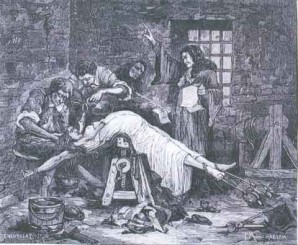
THE INTERROGATIONS
To understand the Italian Law Enforcement Complex it is best to begin with the fundamental premise that individuals each have a place in the system (from Supreme Court Judge to Defendant) and that the events that unfolded in Perugia’s courts are familiar to many other Italian cities.
Many ordinary people have found themselves in extraordinary circumstances.
Mao Zedong once said that “a revolution is not a dinner party…it is an act of violence” and so it is with an interrogation, especially at night, especially for young, frightened and inexperienced university students. Perhaps Raffaele and Amanda would have revolted against the injustice had they seen it coming.
Suffice it to say that Chamomile tea and biscuits do not smooth over being terrorized and tossed into prison.
Coercive methods, rough language and token use of physical force are customary. A slap on the head, for instance, would allow a frightened suspect to assume that they will be beaten next and the abject terror that produces works in the favor of the police. A threat of death produces visceral reactions. And when the interrogators think they already know the truth, prejudice against a subject can induce police to become extremely aggressive and perhaps employ torture. Years ago “questioning” in an Italian Police Station could end much worse, with a flight from a high floor or with severe beatings. Notorious cases, such Pino Pinelli and Giuseppe Gulotta, are a testament to how vicious the third degree can become.

Today things are different and the pretty American girl was only slapped twice in the head and called “Stupid Liar!” The handsome Italian boy was only yelled at; they didn’t actually leave him in a “pool of blood!”
But the real point of Amanda and Raffaele’s interrogations was not to find the truth; it was aimed at confirming the investigator’s suspicions. Twelve officers and several senior officials were scheduled for the interrogations and they had already decided upon a set of “facts,” so the outcome was “prepackaged,” in a manner of speaking. They celebrated when they had enough information to “create” a truth.
The “truth” they wanted took place not long after everyone present (at least 16 people) heard Amanda scream.
In reality the police did not have to work very hard, it barely took two hours to coerce the terrified students into confused ramblings and from there the prosecutor needed only to spin cherry picked phrases to “create” the truth needed to advance their theory. It can be logically deduced, therefore, that anybody who had received the message “see you later, good evening” would be suspected—Diya “Patrick” Lumumba was the unlucky “winner.”
Today, hindsight being 20/20, it should be obvious that authorities had set their sights on Amanda. From the very first day of the investigation Deputy Public Prosecutor Mignini, Deputy Director Giobbi and Chief of Homicide Napoleoni behaved prejudicially toward Amanda, even though technically she (like Raffaele and the others) was only a “person informed of the facts.”
In Italy anyone can be informed of the facts if they are involved in any capacity with a crime. Therefore, all eight people present at the villa when Meredith’s body was discovered were “persons informed of the facts.”
Unfortunately abuse of Italy’s citizens and foreigners occurs in the gray area between “persons informed of facts” and “persons under investigation.” Sometimes authorities will take liberties with a person’s inviolable rights, like wiretapping or surveilling a foreigner without informing their embassy. The British and American equivalents are “witness” and “suspect,” as a comparison, and in all three countries there are laws in place protecting the human rights of both.
But in Italy, on occasion; a defendant might need a Supreme Court ruling to establish which category they belong to during an interrogation, so Raffaele and Amanda have certain rights. One of the few correct acts of Italian justice was when a 2008 Supreme Court ruled that Amanda’s 2007 “spontaneous” declarations were ruled inadmissible exactly because certain protocols that should have protected both students were not followed.
One of the very first “mistakes” made by what is supposed to be a law-abiding, an all-knowing, all-seeing prosecutor.
This ruling, however, did not stop the prosecution or civil lawyers from using the false information. One aspect of Italian law that is frowned upon in the UK and the US is allowing a civil trial to run concurrently with a criminal trial. This element allows for inadmissible evidence from the criminal trial to be heard in the civil trial, sometimes on the same day and in front of the same judges, lay judges, court spectators and media.
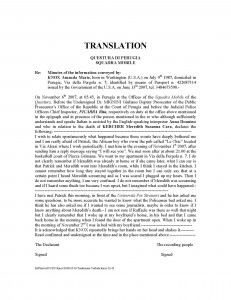
FRAMING, ACT 1
So here we have the first act of The Framing generated by the system itself by coercing Amanda and Raffaele into making confused, but damning, declarations and then compelling them into signing “spontaneous statements.” It is required by law that people “spontaneously” confess to a crime, coercion is prohibited. However, under close examination, coercion is quite evident in this case.
Amanda’s declarations, signed at 1:45am and 5:45am, were written in Italian, despite the language barrier, by the police. Both contained the “visualization” that would be used to implicate Lumumba. Raffaele’s declaration contained the odd statement, “I don’t know if Amanda left or not because I was asleep” and destroyed their alibis.
Because they were scheduled to be interrogated, Raffaele and Amanda had entered the realm of being “persons under investigation” (suspects) and were no longer simply “persons informed of the facts” (witnesses), both should have been afforded a lawyer, and Amanda an accredited interpreter, before the police could proceed with further questioning.
But that did not happen and so, in 2008, the Supreme Court deemed the “spontaneous statements” inadmissible.
However, because the civil trials were heard in court along side the criminal trial, the “inadmissible” statements were referred to on several occasions and a good part of the student’s convictions are based on them.
SIGNIFICANCE
Director Giobbi admitted in his 2009 testimony that it was the first time that Perugia had attempted two interrogations at the same time; a significant event in its own right. That Perugia called for outside help also illustrates that these interrogations were extraordinary. In fact the “Crime of the Century” can accurately be called the most important criminal case that Perugia had seen since…well, probably since the fall of the Roman Empire or the witch burnings of the 1600’s.
The world had arrived to watch the court proceedings and Perugia had never witnessed that.
Hence the claim that the two most important interrogations in years were not recorded because somebody “forgot to press the button” or because there were “budgetary issues” is idiotic. And duplicitous. That this case was of paramount importance from the very start can be proved by a couple of occurrences at the official level, not just by the obvious media attention:
1) Director Edgardo Giobbi, of the Rome-based Serious Crimes Unit (SCU), testified in COURT that “his unit dealt only with important crimes” and that he “arrived in Perugia about 5pm” on November 2, 2007. The local police began arriving about 1:30pm and knew from the outset that Meredith’s death represented international formalities and so was significant enough to call in a team from Rome. Consider that it took the Roman team about a half hour to organize and an hour to go from the outskirts of Rome to Perugia by car, then the Perugians most likely requested SCU intervention no later than 3pm. More than likely the decision to call in help was made shortly after the Perugian team assembled at that scene.
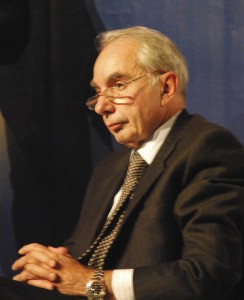
2) After the “Caso Chiuso” (case closed) press conference on November 6, 2007, the Italian Minister of the Interior, Giuliano Amato, commented the on case by “praising the investigators.” Giuliano Amato is no rookie minister trying to ride on the coattails of the “Crime of the Century,” he had previously been the Prime Minister twice and also Minister of Justice. Apparently the last occurrence of a Minister of the Interior commenting on a single “private” murder (no organized crime, no terrorism, no serial killer) dated back to 1958. That in itself is unique.
For Perugia (and not just for Perugia) this is clearly a case like no other, so “Not Pressing the Button” because of “Budgetary Concerns” is an excuse worthy of Anderson Cooper’s “RidicuList.”
More importantly, since it is on record that a “budgetary” issue was raised, the US authorities have the right to demand not only the budget of the Office of the Prosecution of Perugia and of the Perugia Police for Autumn/Winter 2007/2008, but also of the number of interviews recorded and transcripted in that same period as a comparison to see if the budget impacted other cases as well, not just the “Crime of the Century.”
THE SCIENTIFIC INSTIGATIONS
The “human factor” has yet to be fully explored in this case and so an examination into how the technical information was misused is appropriate. The Italian judicial system, after its 1989 Code of Criminal Procedure reform, created a new role called the “Public Prosecutor.” This reform created the concept of the “omnipotent” prosecutor; a person who is able to “mystically” split themselves into two entities to be able to satisfy the law.
This mystical separation occurs during the Investigative Phase only, so from the Preliminary hearing onward the prosecutor becomes “ordinary” again, representing the representing the State. During this period of enlightenment a Public Prosecutor not only works to find evidence favorable to the prosecution’s case, but also works to find evidence favorable to the defendant’s case.
This individual is expected to be more observant, clear-sighted and sharp-witted than the “ordinary” prosecutor (as seen in the US and elsewhere). A person who can step between the roles of Prosecutor and Defender with ease and whose purpose is to assure that everyone’s Inviolable Rights are protected. One could almost say that this person is expected to be a bit of a mystic, a guru who wisely dispenses justice.
Please note that a Public Prosecutor, during the Investigative Phase, being entrusted with searching evidence both for and against the defendants, has “institutionally” a role appearing to be “above the parties.” The Public Prosecutor’s duties include crime evaluation, evidence processing, questioning “persons informed of the facts,” ordinary prosecutorial duties, police duties (like interrogations), and, since he is bound by law to look also for defensive evidence, theoretically also some sort of defense duties.

But humans are notoriously imperfect and unfortunately Italian Public Prosecutors still suffer from the Twelve Nidānas and have many lessons to learn before attaining Nirvana. So what really happens in practice is that if the Prosecutor thinks the defendant is INNOCENT, then no evidence will be found to send them to trial. And if the Prosecutor thinks the defendant is GUILTY, then evidence will be found to send them to trial. This same Prosecutor, if the case goes to trial, as a representative of the State, is then expected to walk the Nobel Eightfold Path, but some fall down on the road to enlightenment.
The prosecutor can have Technical Consultants who also become “above the parties” while working with them. Like the prosecutor, consultants are supposed to be adept at stepping in and out of the dual roles of assisting both defense and prosecution. When called to testify, the consultants retain the “above the parties” status, but as a neutral witness, no longer assisting either party, giving factually correct testimony. That is the theory anyway.
In the normal course of duty a technical consultant may work with a prosecutor for a year or more on a single case; perhaps multiple years on multiple cases, so the downside for these subcontractors is that they will be seen as “prosecutorial consultants” despite being supposedly “neutral.” Their help and support is expected regardless of how absurd or illegal a theory may be and because these consultants are aware of their media exposure as scientific support to a Public Prosecutor, some (ahem) “skew” the evidence in the prosecution’s favor to “preserve harmony.”
FRAMING, ACT 2
In the case of Knox and Sollecito vs. the State another aspect of The Framing centers on the fact that forensic evidence was presented to make the students look guilty. Some evidence was delayed, the Tetramethylbenzidine (TMB) results specifically, or simply withheld, like the Electronic Data Files (EDF) of the DNA tests.
Deputy Public Prosecutor Giuliano Mignini’s technical consultant, Dr. Patrizia Stefanoni, presented paperwork to the courts that contained “gaps” concerning her genetic analysis, like missing electropherograms from the Bra Clasp and Knife, evidence supporting chain-of-custody and lab sanitation for example. But that important evidence was happily neglected by the Italian courts in favor of a “hear no evil” policy in place when law enforcement is involved.

And not just hear no evil; deny any evil exists at all.
For example, the videos of the Italian Scientific Police processing the crime scene are considered by professionals who reviewed them to be a demonstration of what not to do. Yet the Italian Supreme Court (in its notorious 2013 Motivation) said that the videos demonstrated that “the operations of evidence collection, […] took place with the precautions of the protocols of the scientific police, accustomed to interventions of this nature.”
Even though the videos demonstrate below standard protocol being employed the ruling was entered into the legal record. That factually incorrect information is now “set before the court” and the court is telling us that it is required to ignore all else and only rule on what is “before it.”
Now imagine being the innocent people whose lives are affected by this incorrect information. How would you feel if the highest court in the land refused to correct “mistakes” by a lower court to save you from what is, in effect, an illegal prison sentence?
FRAMING, ACT 3
Yet another example of The Framing concerns one aspect of the scientific investigation regarding who was chosen to surrender samples of their DNA and of their footprints. Proper forensic investigation requires that when a house becomes a murder scene, that samples are taken from all of the residents and the guests who may have visited during the period of time in question. If only to exclude them.
But the Kercher investigation, again, did not follow standard protocol as samples were taken only from Amanda, Raffaele, Meredith, and Rudy (after he was apprehended). But mysteriously samples were never requested from the other roommates, Filomena Romanelli and Laura Mezetti, or their boyfriends or Meredith’s boyfriend from downstairs, Giacomo Silenzi, or any of the friends who frequented Via Della Pergola 7.

Without a reference DNA profile or footprint from the other roommates and guests it was impossible to attribute whom the extra peaks belonged to in the so-called “Mixed DNA” (aka “Mixed Blood”) samples found in the villa and on the Infamous Bra Clasp. Amanda’s cellular DNA was identified in the villa samples, not her blood as reported, and that finding was not unusual because the apartment was her home.
Regarding footprints, the police failed to prove that any of the so-called “woman’s size footprints” belonged to Amanda. It was impossible to attribute the “luminol blobs” to anyone and the “single footprint” was later discovered to be Rudy Guede’s. Meredith’s blood had been tracked around the villa by more than 10 “persons informed of the facts” before the Scientific Police even arrived from Rome to secure the scene, several hours after her body was discovered.
Allow me to add, as something else noteworthy, that police also did not interview anyone in the apartment complex just above the villa, though hundreds of people (with a view) lived there. Not one resident was asked about the murder until Paul Ciolino, a private investigator collaborating with CBS on the 48 Hours Mystery “American Girl, Italian Nightmare,” arrived in town months after the murder. He was stunned because, as an investigator himself, he knew that the neighbors are always interviewed after a murder. That’s Crime Scene Investigation 101. So this appears to be a complete collapse of the Investigative Phase and one can only conclude that all of these mistakes show that the technicians were lazy or ignorant.
Or that these examples represent an explicit order by the Deputy Public Prosecutor to the Scientific Police, and that can never be called a “mistake.”

THE LEAKS TO THE PRESS
The Italian Offices of the Prosecutors and Police have more holes that a colino, apparently the Judicial Seal has no powers to keep the media from gaining information about an ongoing investigation. According to Italian law, an active investigation is covered by “judicial secrecy,” laws designed to protect the privacy and reputations of defendants or “persons under investigation” who are “not yet defendants” in a criminal case.
Yet a continual stream of leaks, that slandered and libeled the defendants, “mysteriously” flowed out of the offices of the Perugian judiciary, violating every Honor law.
Sadly this Character Assassination is a common occurrence in all media-worthy cases.
MEREDITH’S FAMILY
Despite filling libraries with noble prose, no justice system is built or maintained for the sake of the victim, it is created and operated for the stability of the society and to the benefit of the State. While prosecutors represent the State, Italy does provide a “voice” in court for a victim because they are perceived as to be “speaking through” their relatives and/or lawyers. So the relatives of victims, or victims themselves (if they survive), can be directly involved in the trial system by becoming a Civil Party, a method unheard of in other countries.
Another unusual aspect is that a Civil Action can be heard alongside a Penal Action in the same trial and on the same days in court. The prosecution gains both the assistance of further attorneys and the moral high ground of having the “voice” of the victim. Both tricks of the system are used to obtain more power in court for the prosecution and put the defense at a distinct disadvantage in the power structure.
The sad reality is that neither a grief stricken family nor public prosecutor are “owners of the truth,” they are simply “a party” in a litigation, the same as the defendants. And a victim’s family is not “above the parties,” this is not an offense or allegation, but simply their judicial position according to Italian law. Therefore their rights should not trump the defendants as both are supposed to have an equal voice in court.
This is true for the Kerchers, just as it is also true for countless other families in Italian history.

CASTA DISASTA
There are faux-political parties in the Italian judiciary called “currents,” which are officially recognized and hold elections. For instance, Judge Alessandro Nencini, who presided over the 2013-14 Second Appeal, belongs to the Magistratura Democratica and is the regional representative for Tuscany of that “Current.” It would be interesting to know which “current” Amanda and Raffaele are floating along in, or if they are caught in a whirlpool of competing “currents.”
“Currents” appeared in the 1950’s and flourished in the 1960’s and 70’s, along with growing political tensions. Currents tend to be “left and right” or “conservatives and liberals” rather than specific political parties.
In March 2013, after the Italian Supreme Court annulled the 2011 acquittal of Amanda and Raffaele by Judges Hellmann and Zanetti, Hellmann stated that he “expected his ruling to be quashed because the Party of the Prosecutors is strong in the Italian magistrature.” This was an unprecedented statement by a judge, especially concerning a case he had been directly involved in.
However, Hellmann’s cryptic reference to a “Party of the Prosecutors” is remarkable because that does not exist as a separate Current. Some think he is referring to a loose association of prosecutors, while others consider that he meant pro-prosecution Supreme Court judges. And the January 2014 Second Appeal ruling appears to illustrate that Meredith, Amanda and Raffaele have become pawns in power plays among the Italian judiciary’s factions.
A sport where truth and justice are secondary, if considered at all, because playing The Game overshadows even innocent lives.
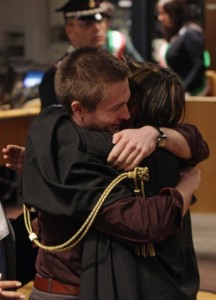
A SHOCK TO THE SYSTEM
On October 3, 2011 Judges Claudio Pratillo Hellmann and Massimo Zanetti stepped outside the system and acquitted Amanda and Raffaele of murdering Meredith. The Hellmann-Zanetti Motivation revealed shocking contempt that a very important case, one of international renown, had been completely botched by the investigators, in particular the scientific examination of the evidence. And because, prior to the First Appeal , each level showed the astonishing deficiency of correcting a long series of “mistakes,” two innocent young people had spent four years in prison.
Unfortunately correcting those “mistakes” of this high-profile case is dangerous; it could set a precedent.
If the Scientific Police could be accused of a lack of professionalism, then defendants could demand adherence to the letter of the law. And judges would be limited by scientific experts and by scientific literature in their rulings. In some cases a defendant would even be able to prove that they were framed.
And the large number of justice seeking individuals, who were framed in a First Instance trial, might overwhelm the system.
Evidently Hellmann’s penchant to “do the right thing” had the Italian Supreme Court (ISC) agitated because their 2013 Motivation threw out nearly every Hellmann and Zanetti finding, but stopped short from “stating” that the defendants “had to be found” guilty at the Second Appeal level. But it came at a sobering price; the highest court in the land debased itself to a lower court by accepting every bit of innuendo and strawman arguments that the prosecution presented. The long gone Sex Game and poop in the toilet came back into play.
The Supreme Court’s act of brutta figura never once addressed the elephant in the room….the complete lack of hard evidence against both defendants.
Above all the ISC’s motivation established two very dangerous precedents in Italian law because the consequences of these rulings will now affect every future trial with controversial DNA evidence or with split trials for the defendants. The courts could now mandate:
1) Proof of when and how evidence was contaminated, while ignoring scientific protocol.
2) That a final fast-track trial ruling became the “Revealed Truth, simply because it was approved by the ISC first, no matter how limited or obsolete the evidence.
THE BOTTOM LINE
In the simplest of terms, during the Investigative Phase (2007-2009) factually incorrect information was created, signed off and entered into the official record by the Perugian Deputy Public Prosecutor and his technical consultants.
Consequently the Ruling Phase (2009 – present) is only able to consider the Factually Incorrect Information precisely because that is “what is before” the Appeal courts and the Italian Supreme Court.
Therefore factually INCORRECT information is being used to convict Raffaele and Amanda of murdering Meredith when there is ample factually CORRECT information to exonerate them and demonstrate before the court that Rudy Guede is the true killer.
The 2011 First Appeal was able to circumvent most of the ‘factually incorrect information’ by examining the only two items in evidence that tied the students to the crime. After proving factual incorrectness by the court appointed experts the knife and bra clasp were thrown out.
Then the students were found innocent because “the crime did not occur,” meaning that they were not involved with the murder.

BE OSMOTIC
A noteworthy by-product of the 2013 Italian Supreme Court (ISC) Motivation is the concept of “osmotic evaluation” of evidence. The term is quite creative and much discussed by both the media and the public, it means “evidence should be considered collectively and not singularly.”
That is the underlying issue with the 2011 Hellmann-Zanetti Motivation from the First Appeal. It addressed only the Knife and Bra Clasp, the items tying the students to the crime, so the prosecution, as the mystical voice of the victim, shilly-shallied. After arguing for years against testing “all evidence” by claiming it was “sufficient,” suddenly they wanted everything tested.
“Trust us,” they had said in 2008, “You don’t need to examine this evidence.” What? Do they think the Jedi Mind Trick actually works?
Suddenly, in 2011, it became high drama to test everything, and of course the hysteria occurred right on the heels of the First Appeal court’s ruling. In 2013 the prosecution petitioned the Supreme Court who decided that “osmotic evaluation” was needed for all of the evidence, even though the lower court had disproved most of it.
The ISC uses the truism “the evidence must be examined collectively and what cannot be proven by a single element of evidence can be proved by multiple elements put together.” But in practice, this case as well as other recent Italian litigations, this apparently correct concept ends up illustrating the problematic “sum them all together and, even if they seem to be inconsistent, there are so many that they cannot all be wrong.”
In my opinion, as the layperson, along with “osmotic evaluation” the judges should apply “reverse osmosis.”
Reverse Osmosis is the technique used to purify a liquid by passing it though a membrane that filters out contaminates. Think filtering water and having a sparkling clean drink at the end. This should be the final step for circumstantial evidence, each item of evidence that has been evaluated and accepted into court should now be “reversed osmotically .”
What is left will be the “Hard Evidence,” enabling the judges to rule fairly because the “white noise” of the factually incorrect evidence is gone.
The Penal Procedural Code mandates that guilt cannot be decided on elements of circumstantial evidence (indizi) unless those items are “serious, precise and agreeing with one another,” so convicting Amanda and Raffaele on evidentiary items that are not serious, precise or agreeing with one another is a mockery of the principal.
In essence, the ISC is saying that every iota of innuendo, character assassination and junk science should be seen as a “whole” to find the truth. Very well, both sides can play this game of “osmotic evaluation” of the evidence, let’s have our own trial, shall we?

THE STATE VS RAFFAELE SOLLECITO AND AMANDA KNOX.
THE DEFENDANTS: The Italian Law Enforcement and Justice System.
THE VICTIMS: Amanda Knox and Raffaele Sollecito.
THE CHARGE: Having framed Amanda Knox and Raffaele Sollecito for a crime they did not commit.
THE EVIDENCE:
1) Rudy Guede could have been an informant, et al, of the police.
2) Raffaele’s DNA on the bra clasp could have been planted.
3) The tapes of the night interrogation could have been deleted or purposely not recorded.
4) False information could have been leaked to the press in order to harm the Amanda and Raffaele.
5) The Scientific Police could have twisted evidence to favor Perugian Deputy Public Prosecutor Mignini.
6) Scientific evidence could have been withheld when favorable to Raffaele and Amanda.
7) Scientific investigations could have been conducted to “prove” that the Mixed DNA traces were attributed to only Amanda.
8) The Perugian authorities could have broken international treaties and national laws in order to frame Raffaele and Amanda.
9) The annulment of the acquittal and the new trial could have occurred because of “party action” inside the magistrate and not because of a proper evaluation done according to the law.
The Defense: “These are speculations, allegations and unconfirmed suppositions. Gross exaggerations of facts not having evidentiary value in themselves. They are arbitrary distortions of innocent events to favor the prosecution’s case.”
The Prosecution: “Maybe, but only if you look at them in isolation. Because when you consider them “osmotically,” all together, there are so many of them that it is impossible they are all wrong or without substance.”
The Ruling: According to the principle of “osmotic evaluation,” the evidence brought by the prosecution is enough to overcome any reasonable doubt and to prove the responsibility of the defendants. This ruling will now set precedent for future courts.
Raffaele Sollecito and Amanda Knox are exonerated because “The Crime Did Not Occur.”
The Sentence: Mandatory resignation and mandatory pilgrimage to Santiago de Compostela by all involved. The penance is “Walking on the knees.”

Many thanks to the blogosphere; the biggest library in the world, and to the numerous professionals wandering among the virtual tomes. Many thanks to all of the Italians who have answered questions, given guidance and helped we foreigners to remember that there are only a few people responsible for this judicial travesty, not the whole of Italy.
Behind the curtain, Mignini and his technical assistants are the correct persons to hold responsible for the “mistakes” made in the case against Raffaele and Amanda. By their hand the Kercher, Knox and Sollecito families, and many others, are suffering.
From a layperson’s perspective, the issue appears to be centered on fact that the Supreme Court does not seem to be powerful enough to overrule “factually incorrect” evidence presented by a Public Prosecutor in the lower courts. I thought they had the power to correct such mistakes, it seems I am wrong. Perhaps there more is dietrologia yet to be discovered.
Or perhaps the position of Deputy Public Prosecutor has attained a mystical level after all, Baphomet.
 Wrongful Conviction News an Injustice anywhere website
Wrongful Conviction News an Injustice anywhere website
